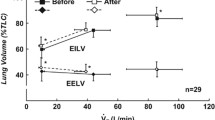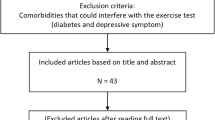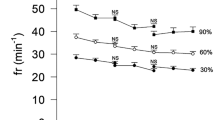Abstract
Research on obese adults has shown that their ventilatory dynamics differ from normal weight adults; however, the ventilatory dynamics of obese and non-obese children have never been documented. Thus, the ventilatory responses of 73 overweight youth (BMI >85th percentile) were compared to 73 age, sex and height-matched normal weight youth (BMI <85th percentile), during 15 min of rest and steady-state exercise at 4, 5.6 and 8 kph. Overweight youth had higher oxygen uptakes (\( \dot{V}{\text{O}}_{2} , \) mL/min), ventilation (\( \dot{V}_{\text{E}} \)), tidal volume (V T), frequency (f R), physiological dead air space (V D) and V D/V T ratios than normal weight youth (P < 0.02); however, end-tidal CO2 (PETCO2), \( \dot{V}_{E} /\dot{V}{\text{O}}_{2} \) and \( \dot{V}_{E} /\dot{V}{\text{CO}}_{2} \) were similar. Inspiratory drive (V T/t i) was greater for overweight youth at rest and during exercise. The correlation between PETCO2 and inspiratory drive was significant for the overweight group at 5.6 and 8 kph (r = 0.23–0.44), but not significant for the normal weight youth (r = −0.04 to 0.10). The greater drive, respiratory frequency and physiologic dead air space of overweight youth suggest that their adiposity modifies ventilation dynamics during exercise. However, the modifications appear to meet the metabolic demands of exercise.


Similar content being viewed by others
References
Brown LK, Schwartz J, Miller A, Pilipski M, Teirstein S (1990) Respiratory drive and pattern during inertially-loaded CO2 rebreathing: implications for models of respiratory mechanics in obesity. Respira Physiol 80:231–244
Browning RA, Baker EA, Herron JA, Kram R (2005) Effects of obesity and sex on the energetic cost and preferred speed of walking. J Appl Physiol 100:390–398
Burki NK (1983) Clinical investigation of abnormalities of ventilatory regulation. South Med J 76:766–772
Cherniack RM (1992) Evaluation of respiratory function in health and disease. Dis Mon 38:505–576
Chlif M, Keochkerian D, Feki Y, Vaidie A, Choquet D, Ahmaidi A (2007) Inspiratory muscle activity during incremental exercise in obese men. Int J Obes 31:1456–1463
Chlif M, Keochkerian D, Choquet D, Vaidie A, Ahmaidi A (2009) Effects of obesity on breathing pattern, ventilatory neural drive and mechanics. Respir Physiol Neurobiol 168:198–202
DeLorey DS, Wyrick BL, Babb TG (2005) Mild-to-moderate obesity: implications for respiratory mechanics at rest and during exercise in young men. Int J Obes 29:1039–1047
Dempsey JA, Reddan W, Balke B, Rankin J (1966) Work capacity determinants and physiologic cost of weight-supported breathing in obesity. J Appl Physiol 21:1815–1820
Derenne JP, Courture J, Iscoe S, Whitlaw A, Milic-Emili J (1976) Occlusion pressure in men rebreathing CO2 under methoxyflurane anesthesia. J Appl Physiol 40:805–814
Eldridge FL (1994) Central integration of mechanisms in exercise hyperpnea. Med Sci Sports Exerc 26:319–327
Gratas-Delamarche A, Mercier J, Ramonatxo M, Dassonville J, Perfaut C (1993) Ventilatory responses of prepubertal boys and adults to carbon dioxide at rest and during exercise. Eur J Appl Physiol 66:25–30
Harrell JS, McMurray RG, Baggett C, Pennell M, Pearce P, Bangdiwala S (2005) Energy costs of physical activities in children and adolescents. Med Sci Sports Exerc 37:329–336
Janssens JP, Pache JC, Nicod LP (1999) Physiological changes in respiratory function associated with aging. Eur Respir J 13:197–205
Kaufman BJ, Ferguson MH, Cherniack RM (1959) Hypoventilation in obesity. J Clin Invest 38:500–511
Keslacy S, Carra J, Ramonatxo M (2008) Role of respiratory system impedance in the difference in ventilatory control between children and adults. Respir Physiol Neurobiol 161:239–245
Margaria R, Aghemo P, Rovelli R (1965) Indirect determination of maximal oxygen consumption in man. J Appl Physiol 20:1070–1073
Marinov B, Kostianev S, Turnovska T (2002) Ventilatory efficiency and rate of perceived exertion in obese and non-obese children performing standardized exercise. Clin Physiol Func Imag 22:254–260
Milic-Emili J (1982) Recent advances in clinical assessment of control of breathing. Lung 160:1–17
Milic-Emili J, Grunstein MM (1976) Drive and timing components of ventilation. Chest 70(Suppl):131–133
Naimark A, Cherniack RM (1960) Compliance of the respiratory system and its components in health and obesity. J Appl Physiol 15:377–382
Narkiewicz K, Kato M, Pesek CA, Somers VK (1999) Human obesity is characterized by a selective potentiation of central chemoreflex sensitivity. Hypertension 33:1153–1158
Ofir D, Laveneziana P, Webb KA, O’Donnell DE (2007) Ventilatory and perceptual responses to cycle exercise in obese women. J Appl Physiol 102:2217–2226
Ondrak KS, McMurray RG (2006) Exercise-induced breathing patterns of youth are related to age and intensity. Eur J Appl Physiol 98:88–96
Parameswaran K, Todd DC, Soth M (2006) Altered respiratory physiology in obesity. Can Respira J 13:203–210
Prioux J, Ramonatxo M, Granier MP, Prefaut C (1997) Changes in maximal exercise ventilation and breathing pattern in boys during growth: a mixed cross-sectional longitudinal study. Acta Physiol Scand 161:447–458
Rowland TW (2005) Children’s exercise physiology. Human Kinetics, Champaign, pp 136–147
Rubinstein I, Zamel N, DuBarry L, Hoffstein V (1990) Airflow limitations in morbidly obese, nonsmoking men. Ann Intern Med 112:828–832
Salvadori A, Fanari P, Tovaglieri I, Giacomotti E, Nibbo F, Belardi F, Longhini E (2008) Ventilation and its control during incremental exercise in obesity. Respira 75:26–33
Vonesh EF, Chinchill VM, Pu K (1996) Goodness-of-fit in generalized nonlinear mixed effects models. Biometrics 52:572–587
Wahba WM (1983) Influence of aging on lung function—clinical significance of change after age twenty. Anesth Analg 62:764–776
Wasserman K, Van Kessel AL, Burton GG (1967) Interaction of physiological mechanisms during exercise. J Appl Physiol 22:71–85
West JB (1979) Respiratory physiology—the essentials. Williams & Wilkins, Baltimore, pp 161–164
Zanconato S, Baraldi E, Santuz P, Rigon F, Vido L, Da Dalt L, Zacchello F (1989) Gas exchange during exercise in obese children. Eur J Pediatr 148:614–617
Zavorsky GS, Murias JM, Kim DJ, Gow J, Christou NV (2007) Poor compensatory hyperventilation in morbidly obese women at peak exercise. Respir Physiol Neurobiol 159:187–195
Acknowledgments
This study was supported by a grant from the National Institute of Nursing Research, grant number NR01-4564 (J.S. Harrell, P.I.). The authors do not have any professional relationship with companies or manufacturers who would benefit from the results of this study.
Author information
Authors and Affiliations
Corresponding author
Additional information
Communicated by Nigel Taylor.
Rights and permissions
About this article
Cite this article
McMurray, R.G., Ondrak, K.S. Effects of being overweight on ventilatory dynamics of youth at rest and during exercise. Eur J Appl Physiol 111, 285–292 (2011). https://doi.org/10.1007/s00421-010-1651-z
Accepted:
Published:
Issue Date:
DOI: https://doi.org/10.1007/s00421-010-1651-z




